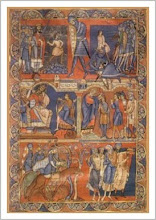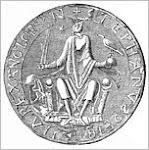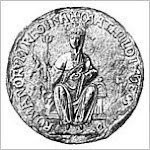• The Heptarchy - The Seven Kingdoms of Anglo-Saxon England
Sussex: Ancient kingdom of the South Saxons
The ancient kingdom of the South Saxons was established in the fifth century after the departure of the Romans. The area had been populated for many thousands of years before then and archaeological finds show that Mesolithic peoples had been in the area. Archaeological collections include a Neanderthal handaxe found at Hamsey near Lewes, primitive flint tools used in fishing and hunting, as well as evidence of woodland clearing. Neolithic tombs with some pottery and weapons have also been discovered and Bronze Age settlements and burial sites can be found in the area. Then the Celts arrived, and their hillforts and burial sites at places such as Cissbury and Devils Dyke show evidence of their settlement.
The first Roman invasion took place between 54-45BC leaving behind Roman coins, temples, and villas. It is a possibility that Cogidumnus became King (Rex) at the time of the second Roman invasion around 100AD. It was also at this time that many of the larger villas were built including Fishbourne and Southwick. Archaeological finds include coins and decorated pottery, and the remains of Roman roads include parts of those from Chichester to London and from Hastings northwards. Settlements also included ports such as Chichester and Portslade on the River Adur. After the Saxon attacks began forts were built around the southeast coast. In the area that would come to be known as Sussex they were Anderitum (Pevensey Castle) and Portus Adurni (Portchester Castle).
According to the Anglo-Saxon Chronicle the Saxons landed in 477AD in the west of the county and began to found the kingdom of the South Saxons under Aelle and his three sons. In 491AD they took the castle at Pevensey. According to Bede, Aelle became the first Bretwalda, or high king, but whatever the case he did become among one of the most prominent and influential of the contemporary Saxon chiefs. After his time however, the kingdom of Sussex gradually declined and fell under the domination of Wessex in 823AD. Archaeological finds include weapons, ornaments and vessels of various kinds, Saxon remains, and numerous cemeteries and scattered burial places along the south slopes of the Downs, including the cemetery on Highdown Hill. The Chanctonbury hoard of coins are among the most notable relics.
Sussex suffered constant raids by the Danes from 895AD and then after the rule of Canute, came under the power of the house of Godwin and then that of the Normans. In fact Norman influence had already been strong in Sussex before the Conquest. For example the estate of Bosham was held by a Norman chaplain to Edward the Confessor and the abbey of Fécamp had an interest in the harbours of Hastings, Rye, Winchelsea and Steyning.
William was very astute and placed the lands in Sussex in the hands of men such as William de Warenne, his son in law, who held Lewes, and Robert, Count of Mortain, his half brother, who held Pevensey. Hastings and Pevensey were on the most direct route to Normandy.
East and West Sussex:
The county of Sussex has been divided into East and West since the twelfth century. East Sussex shares it borders with Kent, Surrey, Brighton and Hove, and of course West Sussex. Its county town is Lewes which has a long history as a market town and gets its name from "Hlaew", which means "hill". Lewes was also the site of a mint in the early years after the Norman Conquest.
Battle is a small town in East Sussex, about 5 miles from Hastings, and the site of the Battle of Hastings in 1066. Battle Abbey was founded by William the Conqueror as a penance and to commemorate the battle and was dedicated in 1095. The high altar of the Abbey church is said to be on the spot where Harold died.
Rye is a small hill top town in East Sussex, on the River Rother. It received its first town charter under the Normans and was fortified during the reign of King Stephen. Although not one of the original Cinque Ports, Rye had become one by the thirteenth century.
West Sussex which borders onto East Sussex, Hampshire and Surrey is very diverse and well known for its stately homes and castles such as Arundel Castle. Chichester is its county town and the county's highest point is Black Down at 919ft.
Lewes Castle:
Situated high above the valley of the River Ouse, on the edge of the South Downs, the Saxon town of Lewes boasts one of the best preserved castle barbicans in England. When William the Conqueror returned to Normandy in 1067 he made grants of land, including the town of Lewes, to one of his lords, William de Warenne. Within a few years he had built an unusual motte and bailey stronghold here, surrounded by defensive earthworks and a moat. Lewes Castle became his main residence, although he did build two other castles, one in Surrey and one in Norfolk. In 1075 the King appointed William de Warenne joint Chief Justiciar, and soon after that he became the first Earl of Surrey.
Arundel Castle:
Erected shortly after the Norman Conquest by Roger de Montgomery in 1067, Arundel Castle was to protect the gap that had been carved by the River Arun through the South Downs. A large castle, of traditional motte and bailey design, with the motte 70ft high and the baileys extending north and south when originally constructed. Original Sussex flintwork on the walls of the south front can still be seen. The inner gateway, built during the eleventh century, is one of the earliest parts to survive. During the twelfth century the Keep was constructed of Caen stone.
• More about Sussex:
• Discover Lewes Castle
• Explore Arundel Castle
• Visit the website South East England
Subscribe to:
Post Comments (Atom)








No comments:
Post a Comment